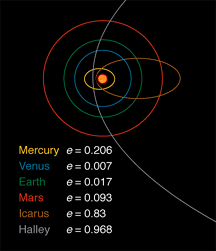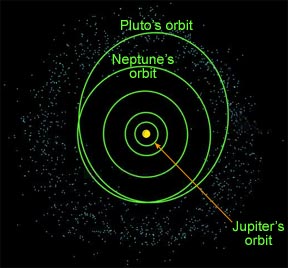Perihelion and Aphelion
All of the planets in our Solar System move around the Sun in elliptical orbits. An ellipse is a shape that can be thought of as a "stretched out" circle or an oval. The Sun is not at the center of the ellipse, as it would be if the orbit were circular. Instead, the Sun is at one of two points called "foci" (which is the plural form of "focus") that are offset from the center. This means that each planet moves closer towards and further away from the Sun during the course of each orbit. The point in the orbit where the planet is closest to the Sun is called "perihelion". The point where the planet is furthest from the Sun is called "aphelion". Earth reaches perihelion in early January each year, and passes through its aphelion point near the start of July. At perihelion, our planet is about 147 million km (91 million miles) from the Sun; it moves outward to around 152 million km (95 million miles) from the Sun at aphelion. Earth is about 3% further from the Sun at aphelion than it is at perihelion. Some people have the mistaken impression that our seasons are caused by changes in Earth's distance from the Sun, but this is not the case. Notice how Earth is actually closest to the Sun in the middle of the (Northern Hemisphere's) winter! Earth's orbit is almost a perfect circle, so the difference between its distance to the Sun at aphelion and at perihelion is slight. Some planets have orbits that are more elongated; astronomers say their orbits have a greater "eccentricity", which is a technical term for how "stretched out" an orbit is. Mercury and Pluto have the most eccentric orbits of the planets. Mercury is 52% further from the Sun at aphelion than it is at perihelion, while Pluto is 66% further away at aphelion than at perihelion. Planets, of course, are not the only objects that orbit the Sun. Many asteroids and comets, and some spacecraft, follow elliptical orbits around the Sun. Any object in such an orbit has both a perihelion and an aphelion point along its orbit. As determined by Kepler and stated in his Second Law of Planetary Motion, the speed of an object in its orbit is fastest at perihelion and slowest at aphelion. The terms perihelion and aphelion apply specifically to objects orbiting the Sun. There are similar terms for the closest and furthest points in orbits around other bodies, such as Earth, the Moon, and other planets and stars. The most commonly used are:
Aphelion is derived from the Greek words "apo" (away from) and "helios" (Sun), while perihelion includes the Greek word "peri" (near). (Note: If you cannot see the animation on this page, or it is not working properly, you may need to download the latest Flash player.) |
 Interactive animation illustrating shapes of orbits
Interactive animation illustrating shapes of orbits















